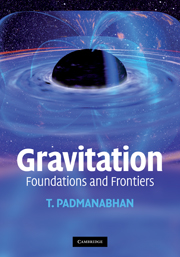Book contents
- Frontmatter
- Contents
- List of exercises
- List of projects
- Preface
- How to use this book
- 1 Special relativity
- 2 Scalar and electromagnetic fields in special relativity
- 3 Gravity and spacetime geometry: the inescapable connection
- 4 Metric tensor, geodesics and covariant derivative
- 5 Curvature of spacetime
- 6 Einstein's field equations and gravitational dynamics
- 7 Spherically symmetric geometry
- 8 Black holes
- 9 Gravitational waves
- 10 Relativistic cosmology
- 11 Differential forms and exterior calculus
- 12 Hamiltonian structure of general relativity
- 13 Evolution of cosmological perturbations
- 14 Quantum field theory in curved spacetime
- 15 Gravity in higher and lower dimensions
- 16 Gravity as an emergent phenomenon
- Notes
- Index
15 - Gravity in higher and lower dimensions
Published online by Cambridge University Press: 05 June 2012
- Frontmatter
- Contents
- List of exercises
- List of projects
- Preface
- How to use this book
- 1 Special relativity
- 2 Scalar and electromagnetic fields in special relativity
- 3 Gravity and spacetime geometry: the inescapable connection
- 4 Metric tensor, geodesics and covariant derivative
- 5 Curvature of spacetime
- 6 Einstein's field equations and gravitational dynamics
- 7 Spherically symmetric geometry
- 8 Black holes
- 9 Gravitational waves
- 10 Relativistic cosmology
- 11 Differential forms and exterior calculus
- 12 Hamiltonian structure of general relativity
- 13 Evolution of cosmological perturbations
- 14 Quantum field theory in curved spacetime
- 15 Gravity in higher and lower dimensions
- 16 Gravity as an emergent phenomenon
- Notes
- Index
Summary
Introduction
Once we venture into spacetime dimensions other than four, the possible theoretical models increase enormously and it is impossible (and, to a certain extent, unnecessary) to do justice to all of them in a comprehensive manner. Hence, in this chapter, we will confine our attention to a few selected topics which deal with the description of gravitational field in dimensions other than four.
The motivation to study gravity in D < 4 is quite different from the motivation to study gravity in D > 4. The interest in two and three spacetime dimensions arises from the hope that the simplified models in these lower dimensions will provide a better understanding of gravity in four dimensions as well as help us to appreciate those features of gravity which are closely tied to the fact that the spacetime has four dimensions. While these models are interesting, it is probably fair to say that the study of lower dimensional models has not significantly enhanced our understanding of general relativity in four dimensions. Therefore, our discussion of these models will be quite brief.
The motivation to study models in D > 4 comes from two key factors. First, there is a very natural class of gravitational theories (called Lanczos–Lovelock models) which exist in higher dimensions and share several properties of Einstein's theory in four dimensions.
- Type
- Chapter
- Information
- GravitationFoundations and Frontiers, pp. 643 - 669Publisher: Cambridge University PressPrint publication year: 2010



